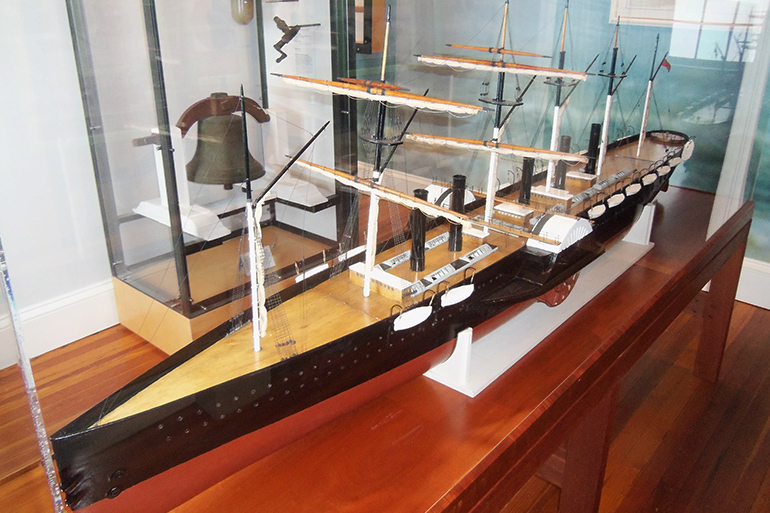Great Eastern: World's Biggest Ship Hits an Underwater Peak Off Montauk

On the morning of August 27, 1862, the keeper of the Montauk Point Lighthouse, William Gardiner, walked outside onto the front lawn to greet the day, only to see the largest ship in the world, by volume six times the size of any other, standing broadside a short distance off the cliff upon which he was standing. It was a stunning sight.
He had read about it in newspapers when it had been launched in England three years earlier, but he never imagined he would see this monster. The Great Eastern was a passenger ship that could carry up to 4,000 wealthy guests. It was nearly 700 feet long, and had three sources of power: sails, paddle wheels and a giant screw in the rear. One paddle wheel was on the port side, one on the starboard. Above deck, six masts with sails alternated with five smokestacks belching coal smoke. Any two of the three power sources could inch this giant monstrosity forward at up to 14 knots. It was certainly like no other ship in the world.
A few passengers were seen on deck, along with some of the 418 crew members who seemed to be running this way and that in panic. The ship was not moving.
Gardiner ran back inside the lighthouse apartment and woke his wife and teenage son, to urge them to come outside. They quickly dressed and did. They all gaped at this wonder of the age.
And then, out of breath and standing there with his family, he saw there was something wrong. The Great Eastern was listing to starboard.
My God, he thought. It’s struck the big underwater rock mentioned on all sea charts. No ship had ever foundered on it before. At low tide, it was still 25 feet below the surface. Could the largest ship in the world have a draft greater than 25 feet?
Gardiner looked down at the three rowboats pulled up on the sand at the foot of the cliff. They were there to help mariners who needed to come ashore. If this ship sank, they would be little more than useless in the catastrophe that would follow.
* * *
The idea for this ship had come from the mind of British engineer Isambard Kingdom Brunel in the 1852. At the time, there was a growing demand for passenger steamships to ply the Atlantic between England and America, and many small ones, packet ships that could carry several hundred people, had been built. Drawing in a sketchbook, Brunel wondered if one gigantic steamship could do the job more efficiently if, for example, it were the size of six smaller ones. It could carry more coal. It could even, if his calculations were correct, go all the way from England to Australia without refueling. It would be a sensation. But could it be done?
He consulted the famous naval architect and ship builder John Scott Russell, who told him yes, it could, but it would have to have an enormous amount of power to survive the high seas in a storm. Russell said that four 2,000-horsepower engines, among the strongest known at the time, could move it forward at 14 knots, easily in calm seas, perhaps with more difficultly in heavy seas. It might be rough to control then. In any case, having the three forms of propulsion would reassure everybody, especially skeptical passengers who had never seen the likes of this before. The men did not know it at the time, but it would be more than 40 years before another ship was built larger than this one. That’s how long it took the shipbuilding industry, now with engines of much greater power, to try something this size again.
For example, the Titanic, built in 1911 and only slightly larger than the Great Eastern, had engines that produced eight times the power. They plowed the ship smartly through the roughest seas at nearly 24 knots until we all know what happened.
But here, half a century before, the Great Eastern was cursed with problems and disasters from the day they decided to build it. For example, in 1857, there was no shipyard big enough to accomplish it. So one had to be purchased and enlarged upon. The men found a spot on the Thames to do this. The weight calculated for the ship, made of iron, would be an unprecedented 19,000 tons. No steam-driven rams were strong enough to push a weight of this magnitude out of a shipyard into the water. A unique solution was proposed. Build it parallel to the water, then use four rams, and push it sideways to slide down the rails into the river.
During the construction, workmen died. At least two were believed to have drowned in the river. A search was conducted, but the bodies could not be found. A huge crowd attended the launch. Henrietta Hope, the daughter of one of the ship’s major fundraisers, christened it with a bottle of Champagne but then could not remember its name and so said, “I name thee Leviathan.” With that, the huge rams were turned on, struggled and failed. The Leviathan, or whatever it was, did not move.
Three weeks later, with more rams placed alongside, another try was made, but that failed too. Only on a third try, with new hydraulic rams lining almost the entire length of the ship, did they get the job done. Next would come the sea trials. The Great Eastern went out, made a U-turn and, suddenly, one of the below-decks steam engines exploded, buckling a smokestack into the sea and killing six crewmen. She limped back to shore. The repairs took a year and bankrupted the shipping company that built her. On another sea trial, the ship’s captain and mate climbed aboard a small tender to row through a storm to shore to disappear in the waves.
Of course, everyone knew the 18,150 square feet of sails would catch on fire if they were unfurled at the same time as the coal fired engines sent black smoke and sparks up and out of the smokestacks. But they tried it anyway in a mix-up. The owners also learned that in the United States, there was no dock big enough to receive the Great Eastern were she to arrive there, so an arrangement was made with the Grand Trunk Railway to have one built at Portland, Maine with an attendant railroad line. But after that dock was built, almost immediately a similar dock was built that size in New York City, so the Maine dock never was used. Railroad companies and the city of Portland sued. Another bankruptcy.
Finally, three trips were made to New York City, but less than a hundred passengers signed on for any of them. The reason was that the American Civil War had broken out and people were just not traveling. On a fourth trip, with 1,500 people on board, the Great Eastern drifted out of control in the Atlantic because the cast iron rudder post had sheared off and the rudder would not function. Eventually, the crew found an ingenious way to attach heavy chains to the rudder and, using the chains as reins, take control.
More problems. One of the trips was delayed four days because the crew reported for work drunk. Another time the crew mutinied for more pay. And then came the underwater rock off Montauk. The Great Eastern was one day out of New York with 1,530 passengers when it ran into a rain squall. With the squall and an accompanying fog reportedly blocking the way into the Narrows and New York Harbor, the captain decided to turn north before the Montauk Point Lighthouse and come into the city in the calmer waters of the Long Island Sound.
The underwater rock gashed a jagged cut into the side of the Great Eastern’s iron hull 83 feet long, and the water rushed in. But the ship had also been built with an inner iron hull, and the rock never reached it. With the inner hull holding, the ship listed five degrees, then seven and eight degrees, but then stopped. It was crippled with something wrong. Never sure what it was, the captain finally ordered the crew to back off whatever it had hit and sail slowly through Long Island Sound and into the city. There, dockside, divers found the gash. It took another three months, with iron plates over the gash, to get her to move again. And there was another bankruptcy.
After that, the underwater rock off Montauk was named the Great Eastern Rock. It remains so today.
A few more trips followed. On one, a paddlewheel was damaged and collapsed while out of service. On another, the Great Eastern ran down a sailboat named Jane, though the crew of that smaller ship survived. At this point, just three years after its launch, the Great Eastern was done as a passenger ship. Its luxurious fittings were stripped away, and it returned to London to be used for a time as a huge floating advertisement, moving up and down the Thames with the name Lewis’s Department Store on its side.
It also became a gymnasium and a music hall for a time. And then, with its vast interior vacant, it was seen to be the perfect vessel for the laying of the first permanent underwater trans-Atlantic telegraph cable. Spools of this cable were stored onboard in giant metal tanks and slowly unwound as the Great Eastern proceeded to complete this task.
In 1889, this ship was taken to a scrapyard on the River Mersey to be dismantled with a wrecking ball. The job would take 18 months. Halfway through this operation, workmen pulled away certain pieces of the iron outer hull to reveal the skeletons of those two workmen lost during the ship’s construction 32 years before. They had been trapped between the outer and inner hulls at the end of one workday. Their bodies were still in there that day at Montauk.
In 2013, the singer Sting wrote a sea chanty called “Ballad of the Great Eastern.”
Here we proudly reprint the third and fourth of the song’s eight verses (composed by Sting, Rob Mathes, Dominic Miller, Kathryn Tickell, Jo Lawry, Peter Tickell and Ira Coleman). These verses describe the time when the great ship was under construction.
A riveter was on the hull with his apprentice lad,
He’d served his time with the older man, some say it was his dad.
200 men upon the shift but when the day is done,
The count is hundred 98…before the setting sun,
They searched the yard all through the night until the morning bell,
No more delays are countenanced by Isambard Brunel,
And so they work a double shift, to make the time in full,
No mention of the missing men…they seal the double hull.
The ship was launched upon the tide and all the townsfolk cheered,
A brass band played but not a word of omens they had feared,
But before the afternoon was out, the celebration wrecked,
A dignitary clutched his heart…and collapsed upon the deck.
No doctors could revive him as the telegraphs would tell,
And the name upon the coffin…Isambard Brunel.



